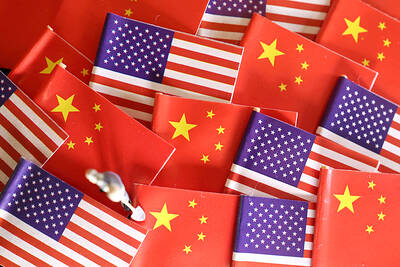Some of us probably had the experience of walking during a heavy downpour and struggling to stay dry in our raincoats while trying to look out for oncoming vehicles through our rain-drenched vision.
What if we had a raincoat that is able to sense how heavy the downpour is and glow in different shades of color and varying intensity.
This would surely be a good device to catch the attention of passing cars and greatly enhance pedestrian safety.

PHOTO COURTESY OF THE CREATIVITY LAB
Many single ladies living alone probably find it hard to do their hair at times, because of the constraints of their bathroom mirror.
What if we had a bathroom mirror that allowed us to see the back of our torso or even magnified parts of our faces, making it easier for ladies to apply their make-up.
These ideas, impractical though they may sound, are totally encouraged at the Creativity Lab (創意中心), a division under the quasi-official Industrial Technology Research Institute (工研院).
And Lin Ying-tzu (林盈孜) is one of these researchers granted the privilege to "daydream" during working hours.
"These thoughts came from my daily observations about life. We are all curious about what will happen in the future and want to know if there are any limitations. But without dreams, there will be no chance to make them a reality at all," Lin said as she shared her ideas for glowing raincoats and reflective mirrors.
Established in March last year in Hsinchu, the Creativity Lab offers a "playful" working environment for researchers, who come from diverse professional backgrounds.
The researchers span different disciplines, ranging from mechanical engineering, chemistry and architecture to psychology, anthropology, as well as arts and humanity.
A look at their business cards is intriguing enough with such innovative titles as future naturalizer, dream maker, inspirational catalyst, pixel magician, wild kid or relationship wizard.
The Creativity Lab was set up to emulate the success of Massachusetts Institute of Technology's (MIT) Media Lab, an institution established in 1985 which pioneered collaboration between academia and industry.
innovation
Sharing the same mission as the Media Lab, which is to serve as an international beacon for creativity, the local lab aims to promote innovation for Taiwanese enterprises, sparking industrial innovation and encouraging cross-sector cooperation.
"Taiwanese enterprises have forged a name in manufacturing capability on the world stage. They are a bunch of fast adapters and excel at meeting clients' requirements. But innovation is a critical element if they want to bring their success to the next level," said the lab's general director Hsueh Wen-jean (薛文珍), whose secondary title is "future producer."
Organizations that are interested in creating added value, especially those that are involved in the brandname business, should cultivate a corporate culture that encourages creativity and empowers staff to think out of the box, Hsueh said.
This is where Creativity Lab comes in. The lab offers a platform to unite experts across various disciplines.
Its primary mission is to enable companies to get rid of stereotypes and dare to be different.
Citing technology firms, Hsueh said that although most of these firms are equipped with both manufacturing and design capabilities, they put too much emphasis on technology and their engineers are always burdened with an 18 month time-to-market constraint.
"This limits product innovation as they can only improve parts of the products at one time to match the company's time-to-market target. Without people from other fields to brainstorm together on what might lie beyond 18 months, they just won't be able to go beyond that," she said.
In a move to nurture an innovative culture which allows crazy ideas, the Creativity Lab launched the Next Consortium (新世代創意聯盟) last December.
The consortium is a platform for multi-disciplinary and cross-industrial collaboration, which aims to develop methodologies for team creativity and create an environment for innovative thinking and realization.
To date, six companies have signed up for the consortium. They include automaker Sanyang Industry Co (三陽工業), chipset designer VIA Technologies Inc (威盛電子), glass artwork workshop Liuligongfang (琉璃工房), precision transmission component maker Hiwin Technologies Corp (上銀科技), projector and rear projection TV producer Chi Lin Optronics Inc (奇菱光電) and sanitary ware manufacturer Hocheng Corp (和成欣業).
By joining the consortium, member companies will be able to interact with researchers from the lab, as well as attend seminars and courses on innovation methodologies -- all of which they can bring back to their organizations.
Media Lab partner
Most importantly, they are granted access to intellectual property resources from both the Creativity Lab and Media Lab, which was roped in as a strategic partner.
The consortium seems to be off to a good start, as more than 20 companies across various industries have shown interest in participating, Hsueh said.
For current member Sanyang, the Next Consortium may offer an answer to surviving in the competitive auto business.
"Taiwanese makers nowadays have too limited a space to be different. Innovation will be the only future niche if we intend to make a name for branded products worldwide," explained Eric Lee (李宜光), technical director of Sanyang's R&D Center.
The annual demand for motorcycles in Taiwan is only 700,000 units -- a small number compared with the 2 million units needed across the Taiwan Strait.
"This creates pressure for Sanyang and makes us struggle to be different to sharpen our competitive edge," he said.
Instead of just imitating what other international makers do, Sanyang is now studying architecture aesthetics and considering applying it to the design of motorcycles.
"Who says there must be an engine and two wheels to make a motorcycle work? We might even come up with a bike speeding on the road on a single wheel in the future," he said with a laugh.
This might sound ridiculous and impossible to most, just as when MIT's Media Lab announced plans in January to introduce its "One Laptop per Child" scheme, which aims to offer notebooks priced at only US$100 for children in the world to bridge the digital gap.
In contrast to regular laptops that sell for US$1,000, the innovations from Media Lab will be 10 times cheaper and will become a reality by the end of next year, with volumes amounting to 5 million to 10 million units.
Nicholas Negroponte, the MIT project director, said on Nov. 30 in Taipei that since the project was announced, the Media Lab has entered into talks with nearly every contract manufacturer of liquid crystal displays and laptops.
There are currently five companies bidding for the deal, including four Taiwanese vendors and one from South Korea.
"The impact of US$100 laptops on the industry or consumer behavior will be far greater than most people have anticipated," Hsueh said.
"Just like the MIT Media Lab, we are trying to explore something which might not even exist now. Commercializing these ideas will be the natural progression for the next step, but for now, we want Taiwanese firms to dare to dream," she said.

‘SWASTICAR’: Tesla CEO Elon Musk’s close association with Donald Trump has prompted opponents to brand him a ‘Nazi’ and resulted in a dramatic drop in sales Demonstrators descended on Tesla Inc dealerships across the US, and in Europe and Canada on Saturday to protest company chief Elon Musk, who has amassed extraordinary power as a top adviser to US President Donald Trump. Waving signs with messages such as “Musk is stealing our money” and “Reclaim our country,” the protests largely took place peacefully following fiery episodes of vandalism on Tesla vehicles, dealerships and other facilities in recent weeks that US officials have denounced as terrorism. Hundreds rallied on Saturday outside the Tesla dealership in Manhattan. Some blasted Musk, the world’s richest man, while others demanded the shuttering of his

ADVERSARIES: The new list includes 11 entities in China and one in Taiwan, which is a local branch of Chinese cloud computing firm Inspur Group The US added dozens of entities to a trade blacklist on Tuesday, the US Department of Commerce said, in part to disrupt Beijing’s artificial intelligence (AI) and advanced computing capabilities. The action affects 80 entities from countries including China, the United Arab Emirates and Iran, with the commerce department citing their “activities contrary to US national security and foreign policy.” Those added to the “entity list” are restricted from obtaining US items and technologies without government authorization. “We will not allow adversaries to exploit American technology to bolster their own militaries and threaten American lives,” US Secretary of Commerce Howard Lutnick said. The entities

Minister of Finance Chuang Tsui-yun (莊翠雲) yesterday told lawmakers that she “would not speculate,” but a “response plan” has been prepared in case Taiwan is targeted by US President Donald Trump’s reciprocal tariffs, which are to be announced on Wednesday next week. The Trump administration, including US Secretary of the Treasury Scott Bessent, has said that much of the proposed reciprocal tariffs would focus on the 15 countries that have the highest trade surpluses with the US. Bessent has referred to those countries as the “dirty 15,” but has not named them. Last year, Taiwan’s US$73.9 billion trade surplus with the US

Prices of gasoline and diesel products at domestic gas stations are to fall NT$0.2 and NT$0.1 per liter respectively this week, even though international crude oil prices rose last week, CPC Corp, Taiwan (台灣中油) and Formosa Petrochemical Corp (台塑石化) said yesterday. International crude oil prices continued rising last week, as the US Energy Information Administration reported a larger-than-expected drop in US commercial crude oil inventories, CPC said in a statement. Based on the company’s floating oil price formula, the cost of crude oil rose 2.38 percent last week from a week earlier, it said. News that US President Donald Trump plans a “secondary